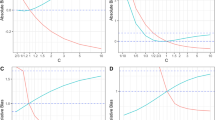Abstract
The concept of attributable risk (AR), introduced more than 50 years ago, quantifies the proportion of cases diseased due to a certain exposure (risk) factor. While valid approaches to the estimation of crude or adjusted AR exist, a problem remains concerning the attribution of AR to each of a set of several exposure factors. Inspired by mathematical game theory, namely, the axioms of fairness and the Shapley value, introduced by Shapley in 1953, the concept of partial AR has been developed. The partial AR offers a unique solution for allocating shares of AR to a number of exposure factors of interest, as illustrated by data from the German Göttingen Risk, Incidence, and Prevalence Study (G.R.I.P.S.).
Access this chapter
Tax calculation will be finalised at checkout
Purchases are for personal use only
Preview
Unable to display preview. Download preview PDF.
Similar content being viewed by others
References
BENICHOU, J. (1991): Methods of adjustment for estimating the attributable risk in case-control studies: a review. Statistics in Medicine, 10, 1753–1773.
BRUZZI, P., GREEN, S.B., BYAR, D.P., BRINTON, L.A. and SCHAIRER, D. (1985): Estimating the population attributable risk for multiple risk factors using case-control data. American Journal of Epidemiology, 122, 904–914.
COX, L.A. (1987): A new measure of attributable risk for public health applications. Management Science, 31, 800–813.
CREMER, P., NAGEL, D., LABROT, B., MUCHE, R., ELSTER, H., MANN, H. and SEIDEL, D. (1991): Göttinger Risiko-, Inzidenz-und Prävalenzstudie (GRIPS). Springer, Berlin.
EIDE, G.E. and GEFELLER, O. (1995): Sequential and average attributable fractions as aids in the selection of preventive strategies. Journal of Clinical Epidemiology, 48, 645–655.
EIDE, G.E. and HEUCH, I. (2001): Attributable fractions: fundamental concepts and their visualization. Statistical Methods in Medical Research, 10, 159–193.
GEFELLER, O. (1992): Comparison of adjusted attributable risk estimators. Statistics in Medicine, 11, 2083–2091.
GEFELLER, O. and EIDE, G.E. (1993): Adjusting attributable risk versus partitioning attributable risk. Statistics in Medicine, 12, 91–94.
GEFELLER, O., LAND, M. and EIDE, G.E. (1998): Averaging attributable fractions in the multifactorial situation: assumptions and interpretation. Journal of Clinical Epidemiology, 51, 437–441.
LAND, M. and GEFELLER, O. (1997): A game-theoretic approach to partitioning attributable risks in epidemiology. Biometrical Journal, 39, 777–792.
LAND, M., VOGEL, C. and GEFELLER, O. (2001): A multifactorial variant of the attributable risk for groups of exposure variables. Biometrical Journal, 43, 461–481.
LEVIN, M.L. (1953): The occurrence of lung cancer in man. Acta Unio Internationalis Contra Cancrum, 9, 531–541.
MIETTINEN, O.S. (1974): Proportion of disease caused or prevented by a given exposure, trait or intervention. American Journal of Epidemiology, 99, 325–332.
ROWE, A.K., POWELL, K.E. and FLANDERS, D. (2004): Why Population Attributable Fractions Can Sum to More Than One. American Journal of Preventive Medicine, 26, 243–249.
SHAPLEY, L.S. (1953): A value for n-person games. In: H. Kuhn and A. Tucker (Eds.): Contributions to the theory of games II. Ann. Math. Studies 28. 307–317.
UTER, W. and PFAHLBERG, A. (1999): The concept of attributable risk in epidemiological practice. Biometrical Journal, 41, 1–9.
WALTER, S.D. (1976): The estimation and interpretation of attributable risk in health research Biometrics, 32, 829–849.
WHITTEMORE, A.S. (1982): Statistical methods for estimating attributable risk from retrospective data. Statistics in Medicine, 1, 229–24.
Author information
Authors and Affiliations
Editor information
Editors and Affiliations
Rights and permissions
Copyright information
© 2005 Springer-Verlag Berlin · Heidelberg
About this paper
Cite this paper
Uter, W., Gefeller, O. (2005). Quantitative Assessment of the Responsibility for the Disease Load in a Population. In: Weihs, C., Gaul, W. (eds) Classification — the Ubiquitous Challenge. Studies in Classification, Data Analysis, and Knowledge Organization. Springer, Berlin, Heidelberg. https://doi.org/10.1007/3-540-28084-7_10
Download citation
DOI: https://doi.org/10.1007/3-540-28084-7_10
Publisher Name: Springer, Berlin, Heidelberg
Print ISBN: 978-3-540-25677-9
Online ISBN: 978-3-540-28084-2
eBook Packages: Mathematics and StatisticsMathematics and Statistics (R0)




